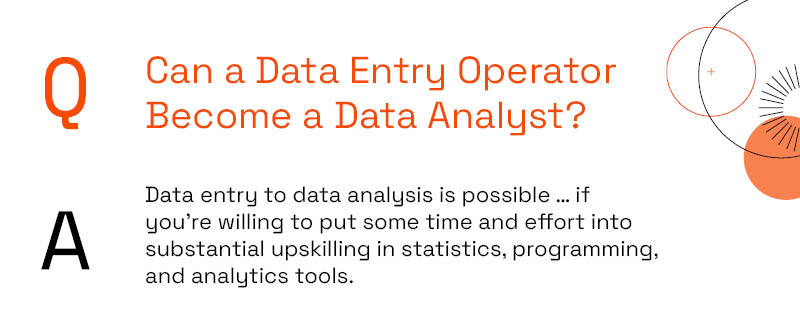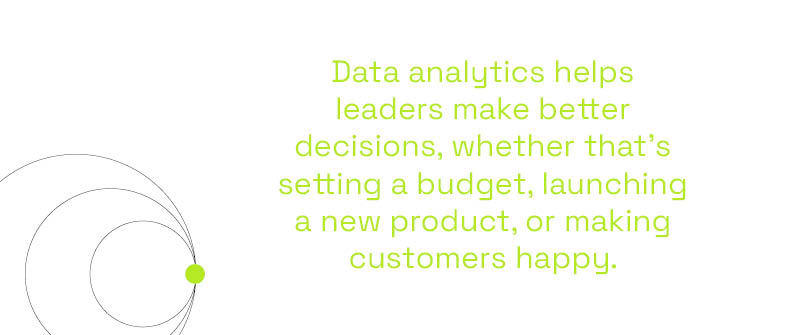
When you hear the words data entry and data analysis, you may think they are pretty much the same thing. Sitting at a desk handling data with endless rows of numbers, right? Well, no, they are actually extremely different roles. Yes, they both involve working with data points, but with totally different goals, distinct demands in database management, and overall very different vibes.
Here, we’ll break down the key differences between data entry and data analysis, explain how careful data collection followed by efficient data processing leads to actionable insights, and share why hiring a data consultant can be a cost‑effective alternative to a full‑time data analyst associate—all while fueling long‑term business growth.
Data Entry vs Data Analysis
Data entry vs. data analysis: is there really a big difference between them? I mean, they both deal with information (or data), spreadsheets, databases, and numbers. But data entry focuses on accurately recording historical data, whereas data analysis interrogates large datasets to uncover trends and opportunities.
Think of data entry as the first step. A data entry specialist inputs information (or raw data) into systems, and while manual entry is still common, automation is playing a growing role. Accuracy is key here. All the data that comes in, from customer info to sales numbers to survey responses, etc., needs to be recorded correctly. Otherwise, it won’t be very useful for the next step. It’s a lot of typing, organizing, and double-checking numbers. It’s a super important part of the data lifecycle. If the data is messy from the start, it’s game over for what comes next.
Next up, data analysis. This begins the more ‘detective’ part of the data journey. Data analysis makes sense of all the information gathered in data entry. A data analyst dives into it, looking for patterns, trends, insights, and answers to questions like, “What’s driving our sales?” or “Why did customer satisfaction drop last quarter?” It’s less about typing in and organizing the data and more about seeing what the data is telling you.
What It Takes to Rock Each Role
Good data entry takes organization, accuracy, and some speed. You’re entering information, keeping records up to date, and handling repetitive tasks. Data entry tasks don’t require deep analysis skills, so there’s not a lot of specialized training needed—it really boils down to following a set of processes. To be a data analyst, you’ll need a knack for critical thinking and problem solving, along with some curiosity (and a touch of creativity). Analysts rely on statistical modeling and statistical analysis—plus programming languages like SQL, R, and Python—to reshape information for visualizations that support decision‑making.
Here’s the thing: when it comes to hiring, there’s usually a big pool of candidates who can fill data entry roles. The average salary for data entry folks is around $33K/year. Finding a good data analyst, though, is a much different ballgame. You’re looking for someone who understands the data, can make sense of it, and can easily communicate their findings to you. Folks with that skill set are a lot harder to find … and more expensive with a salary range of $58 – $95K per Glassdoor.
Beyond the higher salary, you’ll need to consider other costs (recruiting, onboarding, training, and benefits). That’s why hiring a consultant may make sense. You get the expertise you need when you need it, and without the extra costs. Fewer headaches and costs = more value.
Both Roles Matter for Your Business
Why? Well, if you don’t have solid, accurate data entry, your info is messy and probably unreliable. Messy, unreliable data can lead to analysis that’s way off (and potentially not-so-great decisions). On the flip side, if you’ve got great data but no one’s analyzing it properly, well, you’re sitting on a gold mine without a map. Data entry makes sure the data is clean and usable; data analysis turns data into something that can help your business grow and stay competitive.
Can a Data Entry Operator Become a Data Analyst?
Absolutely. If you’re in a data entry position now, then you know how to work with data. You also understand the importance of getting it right, and you’re comfortable working with spreadsheets and databases. If you’re curious and getting the itch to do more with that information, you’ve got the right mindset. Data entry to data analysis is possible … if you’re willing to put some time and effort into substantial upskilling in statistics, programming, and analytics tools.

So What New Skills Do You Need?
Northeastern University listed the top skills for a successful data analytics career including:
· Structured Query Language (SQL)
· Microsoft Excel
· Critical thinking
· Technical tool sets (which vary by role) include coding languages like R or Python; while others may require Power BI/Tableau and Excel.
· Data visualization
· Presentation skills
Also on the list are less technical skills like critical thinking and presentation skills, and a natural curiosity to want to answer questions like, “What is this data telling me?” Good communication skills are also key so you can tell a clear story about data to stakeholders and decision makers.
How to Begin Your Learning Journey
You can go for a bachelor’s degree (computer science, data science, applied mathematics or statistics, to name a few), but it’s not typically required for an entry-level data analyst job. Many professionals have entered the field through bootcamps, certifications, or experiences. There are also alternative pathways and platforms like Coursera, Udemy, and LinkedIn Learning with many courses, so you can pick up skills at your own pace. Look for classes like beginner SQL, Intro to Data Analysis, Data Visualization, Algebra, and Basic Statistics. Even just upping your Excel game can be a big deal. Bootcamps are another great option. They will introduce you to the fundamentals of data analysis and cover skills such as data modeling, database languages, advanced Excel functions, and tools for creating visualizations. Plus, most will have you complete actual projects that you can use in your portfolio for the job hunt.
Let’s take a look at the typical steps:
Step 1: Learn the Basics
Start with some foundational knowledge. Classes in statistics, calculus, linear algebra, and computer science top the list.
Step 2: Build Your Technical Skills
You’ll need some technical skills that can vary by role. SQL and Excel are a must for many entry- to mid-level positions. Coding languages like Python, R, or Java can also be useful. Other roles require tool sets like Power BI or Tableau for data visualization, and skills in data cleaning, prepping, and management.
Step 3: Practice, Practice, Practice
It’s best to learn by working in real-world settings. Look for courses that include hands-on projects or use free public datasets to dig into topics that interest you. That’s how you’ll really learn how to think like a data analyst.
Step 4: Build Your Portfolio
Show off what you’ve learned with a solid portfolio. Include your best projects, and make sure they clearly show your process and insights. A strong portfolio goes a long way in the job hunt.
Your Career Growth, Unfolded
If you’re a newbie to data analytics, your first job might be as a junior analyst. If you have transferable analytical skills, you may be able to grab a data analyst role. Once you’ve gained experience, you can advance your career in a few different directions. You could become a data scientist or, as you develop leadership skills, you could move to an analytics manager or director, or even a chief data officer (CDO).
Have an interest in a specific industry? Your journey could take you to becoming a financial, operations, systems, or healthcare analyst. Once you’ve gained years of experience analyzing data, another option is becoming a consultant, which offers flexibility to dig into a variety of projects and industries. Consultants are often in demand as companies get the expertise they need without all the overhead of a full-time employee.
More great news? Data jobs are in high demand. Companies are drowning in data, so they need people to help dig into it to find insights. And with a salary range of $58 to $95K, it can be a very lucrative career path.
Data Analytics: It’s Kind of a Big Deal
Businesses run on data. Data analytics helps leaders make better decisions, whether that’s setting a budget, launching a new product, or making customers happy. Without it, you may be relying on your gut. But with it, you can move with a plan, spot risks early, and jump on opportunities before your competition does. No wonder businesses are always looking for people who can make sense of the wealth of data they’re gathering. P3 Adaptive has helped countless businesses with their data strategy by helping you use your data to drive decisions across your business.

Is Data Entry Easier Than Data Analysis?
Yes, data entry is generally easier. The focus is accuracy, consistency, and organization. In most cases, it’s typically entry-level with pretty straightforward, detailed work. But some data entry roles require tech proficiency or knowledge in industry-specific tools, including CRMs, ERPs, or regulatory data processes. Data analysis, though, is a whole other level. It’s much more complex and requires more advanced tech skills. You’ll need a mix of tech skills, critical thinking, and great communication skills.
Automation is bringing huge value to both. It’s taking over repetitive tasks for data entry and helping analysts handle large data sets and get faster, deeper insights. Bottom line: Data entry is easier and data analysis is more complex (and more valuable). A consultant can be a cost-effective option, instantly bringing in expertise without the full-time employee price tag.
Conclusion
Data entry and data analysis are very different worlds, but they play equally important roles in the data lifecycle. Data entry can be a great way to get your foot in the door if you’re just starting out. But if you love digging into the ‘why’ behind numbers and connecting the dots, data analysis may be the path for you. And as the world of data keeps growing, jobs in either field aren’t going anywhere.
If you’re struggling to find the right data analyst or want to avoid the long ramp-up, recruitment costs, or the overhead of a full-time team, we can help. Our consultants have the expertise that can give you a strategic advantage. We offer a flexible way to bring fresh insights to the table—in less time than you think. Let’s work together on your data strategy.
Get in touch with a P3 team member